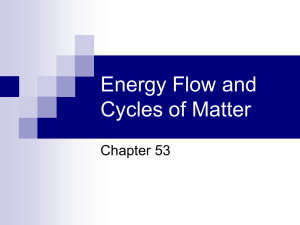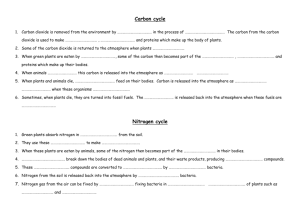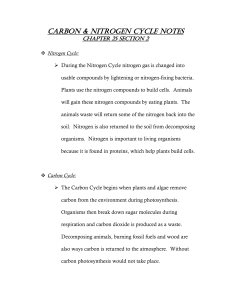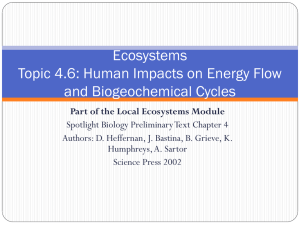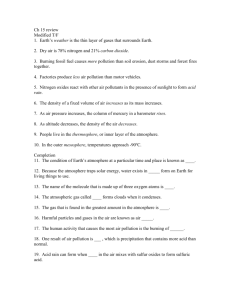In Earth`s ecosystems, energy flows in one direction:
advertisement
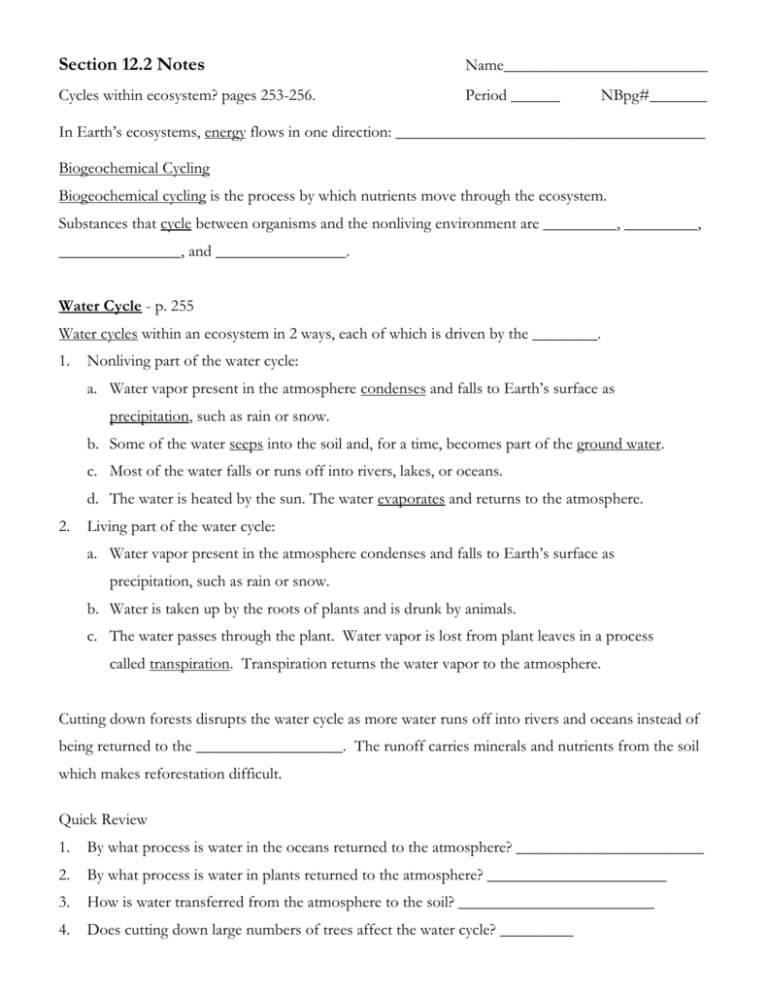
Section 12.2 Notes Name_________________________ Cycles within ecosystem? pages 253-256. Period ______ NBpg#_______ In Earth’s ecosystems, energy flows in one direction: ______________________________________ Biogeochemical Cycling Biogeochemical cycling is the process by which nutrients move through the ecosystem. Substances that cycle between organisms and the nonliving environment are _________, _________, _______________, and ________________. Water Cycle - p. 255 Water cycles within an ecosystem in 2 ways, each of which is driven by the ________. 1. Nonliving part of the water cycle: a. Water vapor present in the atmosphere condenses and falls to Earth’s surface as precipitation, such as rain or snow. b. Some of the water seeps into the soil and, for a time, becomes part of the ground water. c. Most of the water falls or runs off into rivers, lakes, or oceans. d. The water is heated by the sun. The water evaporates and returns to the atmosphere. 2. Living part of the water cycle: a. Water vapor present in the atmosphere condenses and falls to Earth’s surface as precipitation, such as rain or snow. b. Water is taken up by the roots of plants and is drunk by animals. c. The water passes through the plant. Water vapor is lost from plant leaves in a process called transpiration. Transpiration returns the water vapor to the atmosphere. Cutting down forests disrupts the water cycle as more water runs off into rivers and oceans instead of being returned to the __________________. The runoff carries minerals and nutrients from the soil which makes reforestation difficult. Quick Review 1. By what process is water in the oceans returned to the atmosphere? _______________________ 2. By what process is water in plants returned to the atmosphere? ______________________ 3. How is water transferred from the atmosphere to the soil? ________________________ 4. Does cutting down large numbers of trees affect the water cycle? _________ The Water Cycle Tell what is happening at each letter in the diagram. A. _________________________________________________________________________ B. _________________________________________________________________________ C. _________________________________________________________________________ D. _________________________________________________________________________ E. _________________________________________________________________________ F. _________________________________________________________________________ G. _________________________________________________________________________ Carbon Cycle - p. 256 Carbon is another important nutrient. This nutrient moves in cycles bound up in _______________ ______________ or ______________. Carbon is found in the atmosphere or dissolved in water as the gas ____________________ or ____. Photosynthesis is the process by which ____________________ use carbon dioxide to build organic molecules, such as _______________. During photosynthesis, producers give off ______________ gas. Cellular respiration is the process by which organic molecules, such as ________________, are broken down. Cellular respiration occurs in _____________________, ______________________, and _______________________. Cellular respiration requires ______________________ gas and gives off _____________________________ gas. Complete the diagram below of the oxygen and carbon dioxide cycle by following these steps. Write the symbols for the gases, O2 for oxygen and CO2 for carbon dioxide, in all the spaces marked A. Write the process, photosynthesis or cellular respiration, that takes place in all the spaces marked B. On page 256, look at Figure 12.11. What do humans do that puts extra carbon dioxide into the atmosphere? ______________________ _____________ The extra carbon dioxide traps _________ from the sun within the atmosphere. The ability of gases such as carbon dioxide to retain the sun’s heat, and in so doing to warm the atmosphere is called the _______________________________. Quick Review 1. By what process is carbon dioxide removed from the atmosphere to producers? ______________ 2. By what process is carbon dioxide returned to the atmosphere? __________________________ 3. How are humans increasing the concentration of carbon dioxide in the atmosphere? __________ __________________________ 4. The ability of gases to retain heat and warm the atmosphere is called the ___________________ _____________. Nitrogen Cycle - p. 254 Nitrogen is needed by organisms to produce _____________ and __________________________. Nitrogen is found in the atmosphere as the gas ______. The two nitrogen atoms are held together by a strong _________________________ that is difficult to break. A few kinds of bacteria have the enzymes (protein molecules that speed up chemical reactions without being used up in the reactions) to break the strong chemical bond. The nitrogen atoms then bind to hydrogen atoms to form ___________________ or _____. The conversion of nitrogen gas to ammonia is called ________________________________. Ammonia is a form of nitrogen that ____________________________________ and use to make ________________. Animals cannot absorb ammonia so animals get their nitrogen by ___________ __________________________________. Nitrogen fixing bacteria live in soil or within the _________ of some plants such as peas, clover, alfalfa, beans, and alder trees. When an organism dies, the nitrogen in its body is released by _____________________. Quick Review 1. Can all organisms use nitrogen directly from the atmosphere? ___________ 2. Some bacteria make nitrogen available to other organisms by binding hydrogen atoms to a nitrogen atom to form __________________. The process is called _____________________. Phosphorous Cycle Phosphorous is necessary for the production of ______ and ______. ATP is the energy molecule used by the cells of organisms. Phosphorous is in soil and rock as calcium phosphate. Calcium phosphate dissolves in water and can be absorbed by ___________. Consumers eat the plants and obtain ______________________. Study the diagram of the phosphorus cycle shown below. Then answer the questions that follow 1. Phosphate in rocks contribute to the amount of dissolved phosphates by what process? ________________________ 2. The phosphate in plants and animals is converted to dissolved phosphates by what organism? ___________________________________ 3. How do animals acquire the phosphates that they need to make the energy molecule, ATP - adenosine triphosphate? ______________________________________ Phosphorous is added to detergents and fertilizers which can runoff into lakes producing an _____________________. When the algae die, they are decomposed by _________________ using the oxygen dissolved in the water. Aquatic animals die due to a lack of __________________.





